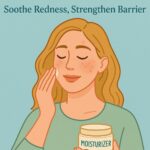
Calm the flare, protect the barrier, and still look put together.
Allergy season can make your face feel like sandpaper and look like a stop sign. Pollen, wind, and constant eye rubbing raise inflammation while tears and antihistamines dehydrate skin. The trick is building a simple plan that reduces triggers, keeps water in, and gives makeup a fighting chance without stinging. Below is a practical routine you can run for four to six weeks, with clear do and don’t rules, timing, and product types that play nicely with reactive, thirsty skin.
What is happening to your skin in allergy season
During high pollen days, your immune system releases histamine. Histamine increases blood flow and nerve sensitivity, which shows up on your face as redness, itch, and that hot, tingly feeling. At the same time, more eye watering and nose blowing means more wiping and friction. Antihistamines help your symptoms but can dry you out. That combination weakens the skin barrier. Water escapes faster and irritants get in easier, so products that felt fine in winter suddenly sting.
Two goals guide everything. First, lower irritation by cutting friction and keeping formulas simple. Second, rebuild and seal the barrier so water stays put and redness cools faster. You will do that with gentle cleansing, water binding layers, lipid rich moisturizers, and sun protection that does not burn your eyes.
Your allergy season routine map
Think of this as a short season program. You can return to stronger actives when pollen drops.
Morning routine
- Cleanse lightly with a very gentle gel or cream. If you did not sweat overnight, a water rinse is fine. Spend 20 seconds and pat dry with a soft towel, pressing rather than rubbing.
- Hydrate in layers. Use a thin humectant step that includes glycerin or hyaluronic acid, then press on a hydrating toner or essence if you like layers. Wait 60 seconds.
- Seal and soothe. Choose a moisturizer with ceramides, cholesterol, and fatty acids. Look for words like barrier cream or repairing lotion. If cheeks are extra tight, dot a few drops of squalane over dry spots.
- Sun protection that does not sting. Pick an eye friendly formula and apply all around the orbital bone, including the upper mobile lid if your product is rated for eyes. Bring SPF down to the nostrils and around the mouth where tissues cause friction.
- Optional redness veil. If you wear makeup, use a thin green correcting primer or a sheer neutralizing tint. Keep it light so it will not pill over SPF.
Evening routine
- Melt and cleanse gently. Remove makeup with a light balm or milky oil, then follow with the same gentle cleanser. Keep water lukewarm.
- Hydrate again. Press on a humectant rich layer. If you are sensitive, favor glycerin, panthenol, and aloe over high strength acids right now.
- Repair and lock. Use a ceramide and cholesterol rich moisturizer. If your face feels hot, choose a gel cream under a thin occlusive pass, like a pea sized amount of petrolatum or a balm on the driest zones only.
- Actives timing. Limit exfoliating acids to once a week and keep retinoids to one or two nights weekly. Put comfort first. If you feel sting from water alone after cleansing, pause all actives for seven days.
Weekly rhythm
- 1 night with a very gentle exfoliant if you are flaking.
- 2 nights with a retinoid if your skin already tolerates it.
- 4 nights recovery only with hydration and barrier cream.
- Any night you sting after cleansing becomes a recovery night.
This rhythm keeps skin moving forward without tipping into irritation.
Makeup that cooperates when skin is reactive
Base products can amplify redness or smooth it. Keep the math simple. Hydrate first, then a thin moisturizer, then SPF, then wait one minute before base. Reach for sheer to medium coverage with a natural finish. If you need extra help around the nose and cheeks, touch in a small amount of color corrector under foundation rather than piling on layers. Powder only where you crease or get shiny. Blush looks best when skin is calm, so pick creams with a satin finish and tap, do not drag. At the end of the day, remove everything gently and reset the barrier.
Quick fixes vs long term habits
Quick fixes that help right away
- A cool compress for five minutes before moisturizer reduces surface heat.
- A hydrating mist used under moisturizer, not on top, holds water better.
- A thin occlusive pass on the reddest areas at night stops overnight water loss.
Long term habits that reduce flare frequency
- Wash pillowcases every two to three days during high pollen counts.
- Run a HEPA filter in the bedroom and keep windows closed on peak days.
- Keep nails trimmed and use a clean tissue to dab eyes instead of rubbing.
- Build a two step hydration plus barrier routine year round so skin enters allergy season stronger.
When to use actives and when to skip
You can still use actives in allergy season, but cadence and pairings matter. Limit low pH acids to once weekly, pick lactic acid over glycolic if you run sensitive, and run it on its own night without retinoids. Keep niacinamide at modest levels and avoid stacking it with strong acids in the same pass to reduce prickle. If your routine normally includes vitamin C in the morning, you can keep it if it does not sting. If it does, park it for two weeks and lean on hydration. The win is consistent comfort, not a perfect calendar.
Do and don’t list for calmer weeks
Do keep water lukewarm, keep towels soft, and use fragrance free or very lightly scented products near eyes. Do reapply a bland lip balm often. Do bring SPF all the way to the lash line with a formula designed for eyes. Do carry a travel tube of barrier cream and touch up the nostril area after tissues.
Don’t stack acids and retinoids on the same night. Don’t exfoliate flakes off with pressure. Don’t use menthol or peppermint near eyes. Don’t try new perfume on the neck on high pollen days, since scent plus friction can aggravate redness.
Troubleshooting common allergy season issues
- Skin looks glossy but feels tight. You are oily dehydrated. Add a humectant layer under a light gel cream. Keep cleansers gentle and reduce clay masks to once weekly.
- New stinging from your usual moisturizer. Your barrier is too open right now. Switch to a simpler ceramide rich cream and pause actives for seven days.
- Makeup cakes over flakes by noon. Increase morning hydration and switch to a satin base. Tap a micro amount of balm on flakes after the base to smooth them down.
- SPF burns eyes. Change the filter type or base. Use an eye safe sunscreen and apply first, letting it set before the rest of your routine.
Final Thoughts
Allergy season asks for a shorter, calmer routine. Build comfort first with gentle cleansing, water binding layers, and a rich but breathable seal. Keep actives on a light cadence. Protect your eyes and nose area, where friction is highest. A steady two to four weeks like this usually gets redness down and hydration back up. When pollen dips, slowly return to your usual routine by adding one active at a time every seven days. Your skin should feel quiet, flexible, and less reactive the next time the season rolls in.
See also
If you keep seeing redness after product layering, Ingredient Clash List to Avoid shows which pairs to separate so you can stay comfortable while still getting results. If congested pores are riding along with irritation, Pore Care Without Wrecking Barrier lays out a gentle plan that clears without stripping. For eye friendly protection on watery days, Sunscreen for Eyes and Lids That Don’t Sting walks through formulas and placement that will not burn.
When your skin needs extra rebuilding, Ceramide Moisturizers for Damaged Skin Barrier rounds up textures that calm fast. If you want to keep some exfoliation in the mix without setbacks, Best Exfoliators for Sensitive Skin maps milder options and safe cadence.
FAQs
1) Can I keep using retinoids during allergy season
Yes, but cut frequency to one or two nights a week and keep those nights separate from acids. If water alone stings after cleansing, pause retinoids for a week.
2) My skin is red after antihistamines. Is that normal
Antihistamines can dry you out, which highlights redness. Increase hydration layers and use a richer barrier cream at night. If redness is severe or new for you, speak with a professional.
3) Should I switch to mineral sunscreen
If chemical filters burn your eyes, mineral options often feel calmer. Pick a texture that spreads easily and reapply as needed. The best sunscreen is the one you can wear daily without sting.
4) How do I exfoliate flakes without making redness worse
Use a very gentle acid once weekly or a soft washcloth with water only. Follow with hydration and a barrier cream. Do not scrub or stack multiple exfoliants.
5) Can I use a face mist all day
Yes, but it works best under moisturizer, not on top. If you mist later, add a tiny amount of moisturizer afterward to trap the water so it does not evaporate and leave you drier.
Affiliate Disclosure
If you purchase through links on our site, we may earn a small commission at no extra cost to you.




